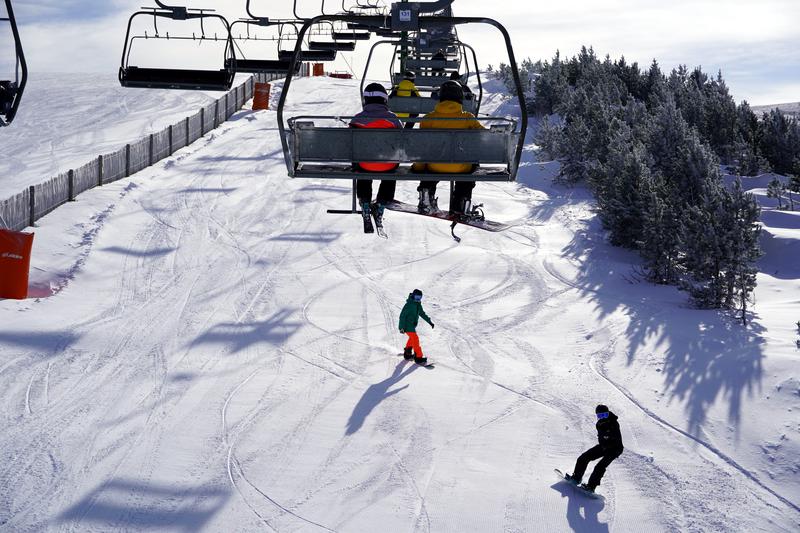Skiing at a crossroads: bringing prosperity or gentrification and climate drama to the Pyrenees?
Ski resorts account for a fifth of region's economy but housing prices and artificial snow amid drought raise eyebrows

Marcel Sangenís is a young resident of Cerdanya county, at the heart of the Catalan Pyrenees, and made a very brave move not so long ago: he graduated in biology in Barcelona, completing postgraduate studies and a master's degree allowing him to work at a multinational firm. But he decided to give up this life to return to his hometown in the mountains.
He admits he loves the place where he was raised and its way of life although moving back came at the expense of his career. He is now a cook and the job prospects he may have had in his field after his studies have faded.
He tells Catalan News that most of his friends that left the area to go to university have not returned because they see no opportunities. "The future of undergraduates and postgraduates here is working at a place making gin and tonics for tourists," he says, linking the issue to skiing.
Skiing brings jobs to Pyrenees, but are working conditions decent?
This activity generates 3,000 full-time jobs year-round if including all of the sector's seasonal contracts, according to the Catalan government.
"We generate a lot of jobs, either directly with our staff, or indirectly, with ski schools, hotels, and restaurants," says the head of the commercial department at the La Molina ski resort, Marta Viver.
And indeed, 17.5% of the Pyrenean areas' gross value added, an indicator similar to GDP, comes from this sector.
Yet, for Sangenís, this activity "has contributed to the county's economy for years, but if we see how wealth was distributed, the jobs it creates are precarious and temporary, and usually badly paid."
However, Viver does not feel represented by this rather gloomy description, making clear that the Catalan government, which owns seven out of the ten Alpine skiing resorts through its public company FGC, offers its employees very good conditions.
La Cerdanya building rate 12 times higher than average
Marcel Sangenís is a member of Stop Jocs Olímpics, or Stop the Winter Olympics, a group strongly opposed to future projects to brin the Games to the Pyrenees, and also to the gentrification brought by tourism. The activist randomly picked where to meet with Catalan News, the town of Ger.
There are around 80 houses that are being built in this municipality of 500 residents, and this is but an example of the elevated building rate in La Cerdanya, which is 12 times higher than the Catalan average according to local housing activists.
In this county, 53% of homes are second residences, the highest rate in Catalonia and a similar one to other Pyrenean areas, says the Catalan statistics institute (Idescat)
On average, renting a flat costs 600 euros per month in La Cerdanya, also according to Idescat. But what is especially soaring are the cost of sales, with prices averaging 2,700 euros per square meter, only matched with rates in Barcelona and its surroundings.
Marta says skiing has nothing to do with this building madness and it is up to local and regional authorities to regulate it, but Marcel believes the sport is one of the main attention grabbers.
"To me, leaving home means spending 80% of my salary on rent," he says, arguing that the houses that are being built in Ger are not for locals.
"How many lives has someone employed in tourism need to work to pay for a 600,000 euro home?" he wonders. "We are building ghost villages, with no people, they are just theme parks open 20 days a year."
Artificial snow needed amid drought and energy crisis
On top of gentrification, the future of skiing may be threatened by climate change.
While recent snowstorms were very welcome in the sector, the season did not get off to a good start this year. A warm and dry late autumn forced ski resorts to depend more on artificial snow than usual. And that means using a lot of water amid the ongoing drought in Catalonia.
Marta Viver does not hide the fact that 600 snow cannons feed La Molina's ski runs, but she explains to Catalan News that it is made from their own water from a closed cycle.
"In the spring, we store all the water from melted snow and rain, and then in the winter, we return all this water to the runs as artificial snow," she says. "What's more, snow cannons are more and more modern now thanks to technology, and therefore they consume less energy."
These arguments do not persuade Marcel, however. "Some villages in my municipality suffered drought-related water restrictions. What's the point in ski resorts never facing these measures?" he asks. "Supposedly the rainwater that falls in their premises is theirs, but some studies suggest over 40% of water evaporation."
The La Molina official says, "snow is produced only when it is really necessary," but whether climate change will make ski resorts more and more dependent on these machines remains to be seen.
"We all want longer ski seasons every year. And in fact, they were shorter in the past. So we haven't seen an impact," she adds, referring to climate change. "I think the snow and cold will continue and so we will keep on skiing."
Marcel is not as optimistic and believes ski remains strong thanks to public spending – the three private Alpine ski resorts also get public financial aid – that could be spent on boosting the local economy with industry, agriculture, food, and other sectors that "do not only benefit just a few people."
For him, it is all now mainly focused on serving middle and upper-class people from outside La Cerdanya who want to ski and enjoy their luxurious second homes.